factorio
Note: This post describes complex workarounds for challenges that have been addressed by quality of life features in Factorio. For a detailed look at these improvements, see my new post: A Thank You to the Factorio Devs: An End to Complex Workarounds.
Logistic Circuits Part 2 - Automatic indexes, trash trains, faster unloaders
This is a continuation of the first post.
Writing the first part of this series has been a very rewarding experience. I’m re-learning how valuable teaching is for both the writer and the reader.
Revisiting my old circuits to explain how they function has already revealed many areas for improvement. I made some of those improvements while publishing Part 1, and I’ve got a few more to walk through in this post.
Unloader improvements
Adding a dedicated trash train was long overdue. Previously, the seed train doubled as my trash train. Over-filling the seed module’s manifest would leave little to no room to return items to base.
During base expansion, I create and destroy many of these logistic stations. Waiting for stations to deconstruct so I could move the perimeter wall or clean up my rail network cost me hours of wait time and round trips.
I came up with a partial fix, which I included in the last blueprint book:
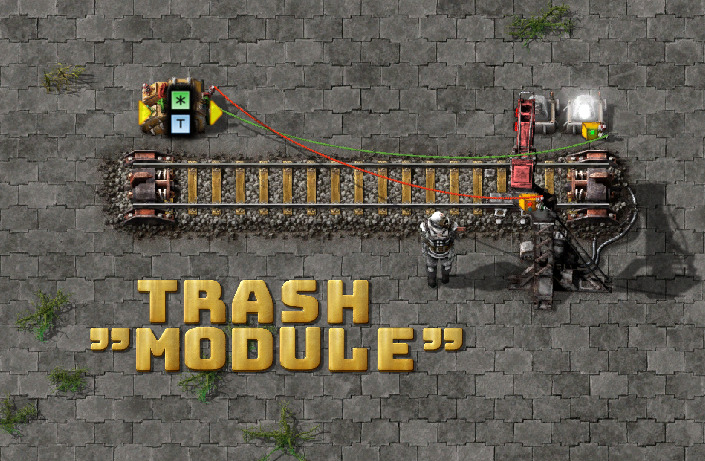
This would replace the seed train stop with a dedicated trash train. However, this worked best when I was destroying an outpost; in other cases, it required manual fixups. There’s no substitute for building this feature directly into the outpost:
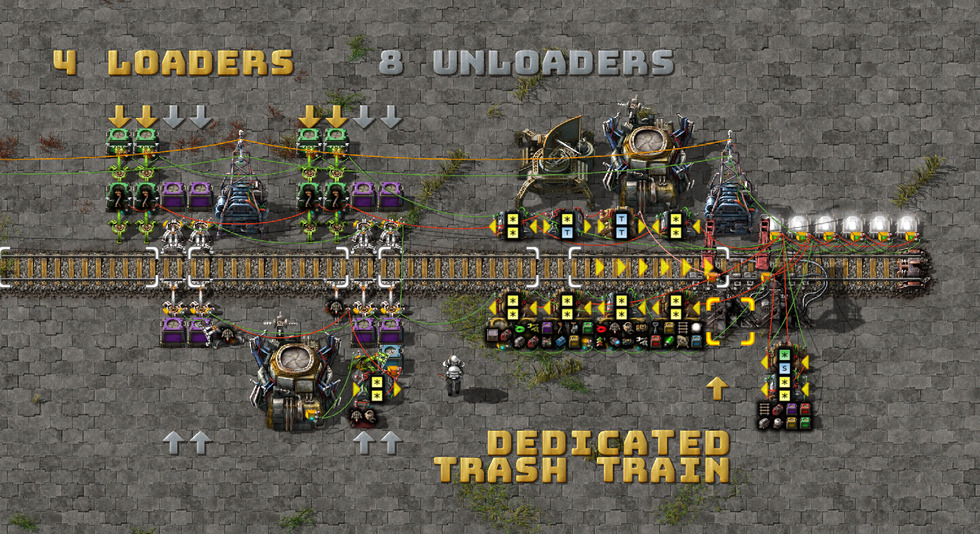
I’m using a new trick here, too: buffer chests to replace the requester and steel chests. These have a major advantage over the prior setup, as they allow player logistics, construction robots, and regular logistics (assemblers, smelters) to pull from the trash chests while a train is en route.
I frequently found that when refactoring outposts, I would flush all my beacons, modules, and assemblers through the trash circuit. When using requester and steel chests, I was unable to use those items again until a resupply train arrived (the trash items would be loaded and then unloaded immediately—still a PITA).
Using buffer chests in set-requests mode is the best of both worlds. It behaves like a requester chest, it won’t pull from other buffer chests, and it makes itself available to the logistics network.
The trash inserters don’t need to overlap with the module slot inserter alignments, so I found there was room for another four unloaders (from four to eight).
Cleaner index circuit
I found a way to shrink the indexer circuit by using a negative mask rather than the *1.0M, >1.0M, -1.0M trick from the previous post, which removes four combinators.

Blueprint.txt
Install the Text Plates mod if needed.
I made some concessions, though: the circuit will no longer pause when the train is fully loaded. This was most annoying when I was standing over it and building it. Most of the time, I’m elsewhere.
Let’s explode the circuit and do a walkthrough:
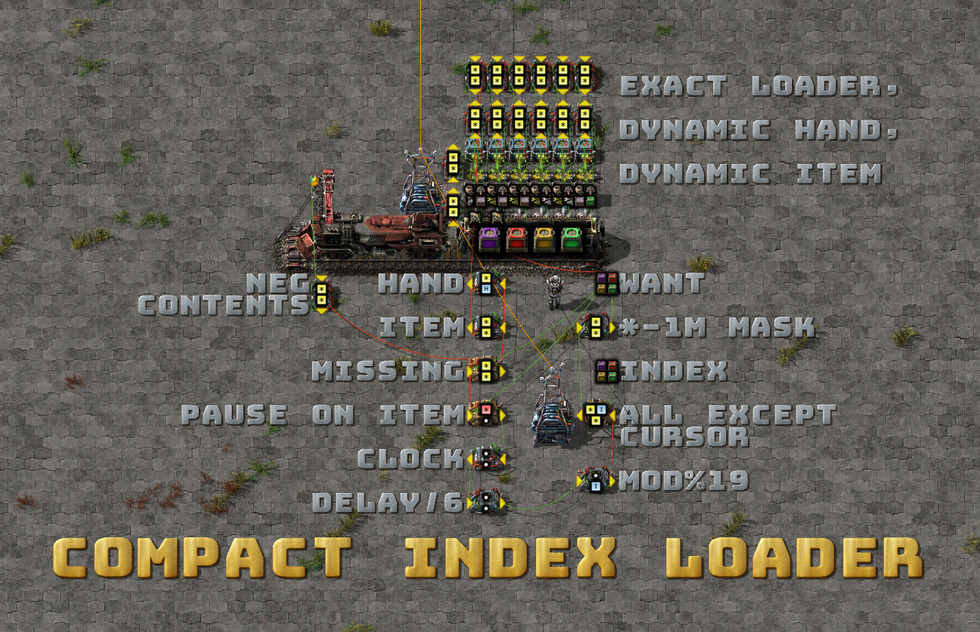
There are two changes. The indexer circuit now outputs everything except the cursor: [*each] != [I]. I then use [*each] * -1.0M to create a negative mask that’s joined with the WANT constant combinator.
The MISSING combinator takes three input signals:
- The
WANTsignal:{ rail: 100, chest: 50, inserter: 10 } - The negative mask from the indexer:
{ rail: -1M, inserter: -1M }whenchestis selected. - The (negative) train contents:
{ rail: -80, chest: -10 }
Which sum to: { rail: -1M, chest: 40, inserter: -1M }.
The MISSING combinator filters negative values with [*each] > 0 -> [*each]. Now we have an isolated item signal of exactly what’s missing—{ chest: 40 }—which is perfect for calculating the filter inserter’s hand size and filter item (HAND, ITEM).
Pain Point: Index Management
Index management is a pain. Setting new requests remotely requires a lot of fiddling to correctly upgrade the manifests and indexes for each loader.
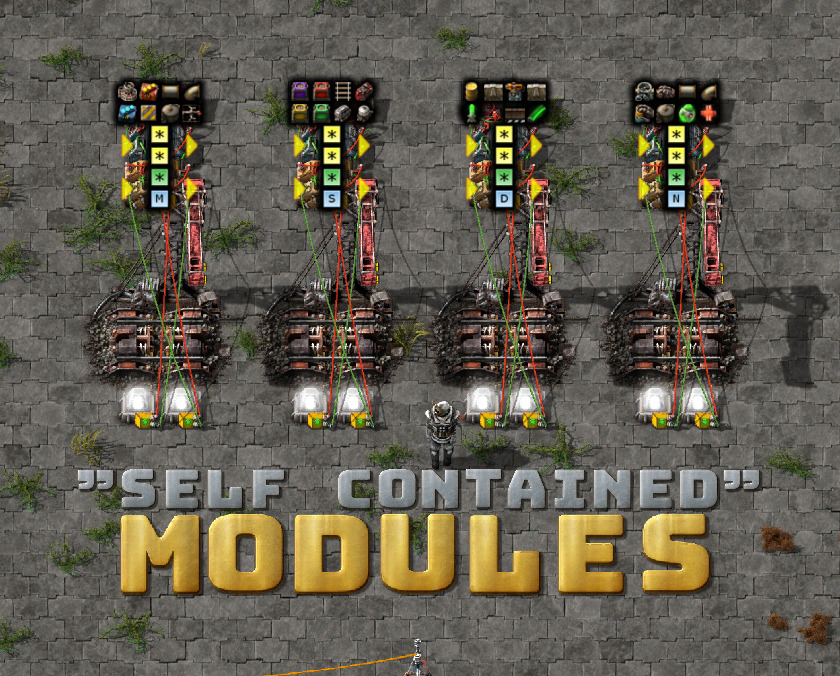
The dream is to plonk down an upgraded, self-contained module at the loader and unloader and have the circuit make all the necessary adjustments at both ends.
There are at least two missing pieces:
- Generating an index from the manifest signal automatically. This would also ensure the index stays in sync with the manifest’s items.
- Balancing items over multiple wagons (otherwise, we’d be limited to 40 item types for the entire train). (Spoiler: I haven’t solved this yet.)
Automatic indexer
Last week, I thought this was impossible—and perhaps it should be. Here is a compact, fast, exact, auto-indexing logistic loader circuit that also resets the train loader cache, index, and index builder when the manifest changes.
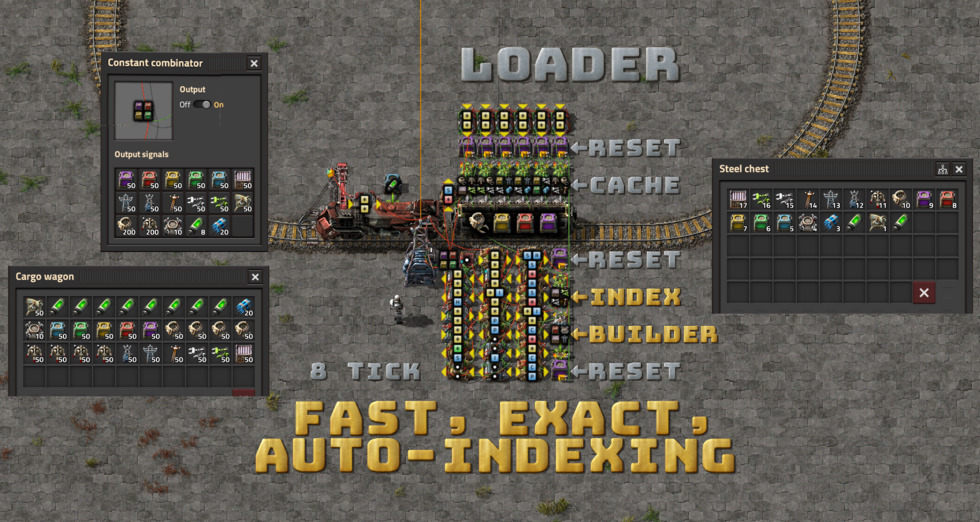
blueprint.txt
Top-left is the request manifest (constant combinator).
Bottom-left is the exact cargo wagon contents.
Right is the index state, built to match the items in the request signal.
I use the steel chest as persistent storage for the index.
The brainwave for this came after I read a Reddit comment on the first post. I can use a filter inserter to select and isolate a single item from a mixed-item signal.
Naturally, this will only work for item signals, and you’ll need to have those items in the current logistic network while building the index.
Previously, I thought this would only be possible by using a Lua script to generate a massive constant combinator array programmed with all the in-game items. This wouldn’t be robust enough for non-vanilla items (without re-running the script in each context), it has a huge footprint (at least 12 combinators), and the iteration times over ~250 items to use just 10 of them was very slow. The manual index was a huge improvement at the time.
Index building
The procedure is as follows:
- Iterate over the index range
(1..18)with[clock] % 19. - Count the number of item types at the current index position with
[*each] -> C: 1. - If multiple items are found (
[C]ount > 1):- Pause the clock.
- Insert one of the items into the chest, which moves it into the next slot.
- Repeat.
Let’s simulate it with a bit of Rust:
fn main() {
let mut db: std::collections::BTreeMap<char, i32> = ['A', 'B', 'C', 'D', 'E', 'F']
.iter()
.map(|&item| (item, 1))
.collect();
let mut clock: i32 = 1234;
loop {
for (k, v) in &db {
print!("{}{} ", k, v);
}
// convert clock signal into index position
let index = clock % 19;
// find items at this index position
let items: Vec<char> = db
.iter()
.filter_map(|(k, v)| if *v == index { Some(*k) } else { None })
.collect();
let count = items.len();
print!("- index: {}", index);
if count > 0 {
print!(", items: {}", items.iter().collect::<String>());
}
if count > 1 {
let first = items[0];
// insert one of the multiple items to move it into the next slot (higher value).
db.entry(first).and_modify(|e| *e += 1);
println!(", insert: {}", first);
} else {
// resume clock
clock += 1;
println!(", resume");
}
let mut values: Vec<&i32> = db.values().collect();
values.sort();
values.dedup();
if values.len() == db.len() && count == 0 {
println!("done!");
break;
}
}
}
A1 B1 C1 D1 E1 F1 - index: 18, resume
A1 B1 C1 D1 E1 F1 - index: 0, resume
A1 B1 C1 D1 E1 F1 - index: 1, items: ABCDEF, insert: A
A2 B1 C1 D1 E1 F1 - index: 1, items: BCDEF, insert: B
A2 B2 C1 D1 E1 F1 - index: 1, items: CDEF, insert: C
A2 B2 C2 D1 E1 F1 - index: 1, items: DEF, insert: D
A2 B2 C2 D2 E1 F1 - index: 1, items: EF, insert: E
A2 B2 C2 D2 E2 F1 - index: 1, items: F, resume
A2 B2 C2 D2 E2 F1 - index: 2, items: ABCDE, insert: A
A3 B2 C2 D2 E2 F1 - index: 2, items: BCDE, insert: B
A3 B3 C2 D2 E2 F1 - index: 2, items: CDE, insert: C
A3 B3 C3 D2 E2 F1 - index: 2, items: DE, insert: D
A3 B3 C3 D3 E2 F1 - index: 2, items: E, resume
A3 B3 C3 D3 E2 F1 - index: 3, items: ABCD, insert: A
A4 B3 C3 D3 E2 F1 - index: 3, items: BCD, insert: B
A4 B4 C3 D3 E2 F1 - index: 3, items: CD, insert: C
A4 B4 C4 D3 E2 F1 - index: 3, items: D, resume
A4 B4 C4 D3 E2 F1 - index: 4, items: ABC, insert: A
A5 B4 C4 D3 E2 F1 - index: 4, items: BC, insert: B
A5 B5 C4 D3 E2 F1 - index: 4, items: C, resume
A5 B5 C4 D3 E2 F1 - index: 5, items: AB, insert: A
A6 B5 C4 D3 E2 F1 - index: 5, items: B, resume
A6 B5 C4 D3 E2 F1 - index: 6, items: A, resume
A6 B5 C4 D3 E2 F1 - index: 7, resume
done!
We’ve converted our request signal, A1 B1 C1 D1 E1 F1, into a unique index, A6 B5 C4 D3 E2 F1. Woo!
Let’s match this to the circuit:
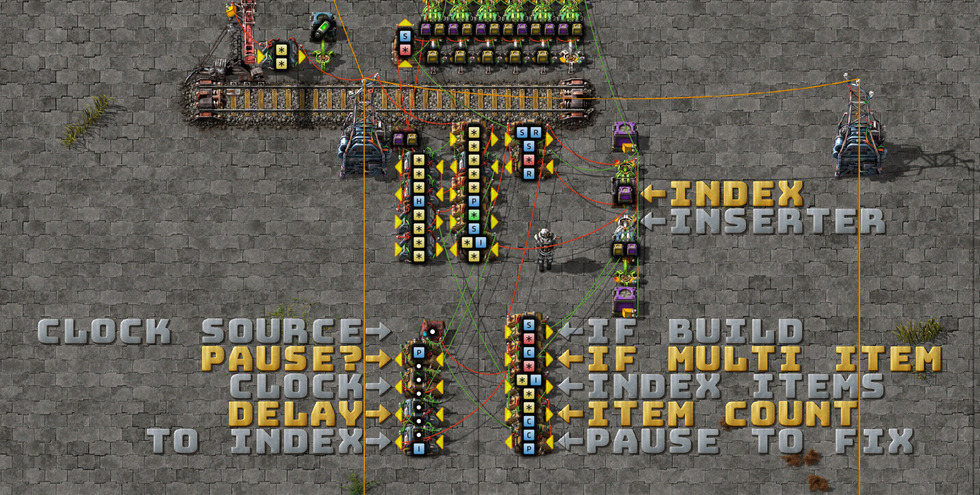
The CLOCK SOURCE, PAUSE?, CLOCK, and TO INDEX combinators are familiar elements from prior circuits.
INDEX is the persistent memory where the index is built, and INSERTER is how we shift items up the index slots one by one (hand size: 1).
IF BUILD checks if we’re in index-building mode; the other mode, FLUSH, is triggered when the constant combinator changes. When triggered, FLUSH mode will flush all caches and chests (train loading cache, index chest, and requester chest). More on this later.
INDEX ITEMS selects all items at the given index position with [*each] == [I] -> [*each]: 1.
ITEM COUNT emits C: 1 for each item found at the current index position. If C > 1, we pause the clock (PAUSE TO FIX) while we fix this index position.
IF MULTI ITEM sends a signal to the filter inserter and requester chest if C > 1.
Now, with what I’ve explained so far, there’s a big off-by-one error. The item at index position 1 will never be inserted into the chest because of the base request signal ({ rail: 1, chest: 1, inserter: 1, ... }). We need a way to invalidate the index=1 position. I did this by reusing the clock source dot: 1 to occupy that slot and push every other item up a slot. The dot signal is not an item and can’t be inserted.
Flush circuit
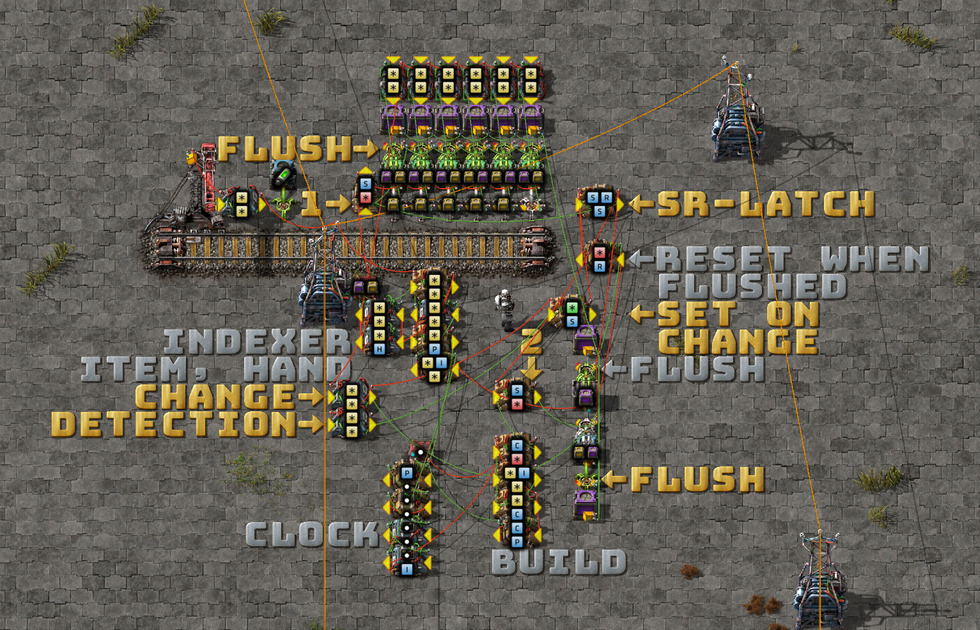
This is the second circuit mode, which flushes all state after a manifest change and then allows an index rebuild to start from a known-good state (zero).
The FLUSH trigger is a small, three-combinator change-detection circuit. Both arithmetic combinators do [*each] ^ 0 -> [*each] to normalize the request signals. The output of the first is fed into the second, and then both are fed into the SET ON CHANGE decider with the condition [*each] != 2 -> S: 1.
In the steady state, each value in the SET ON CHANGE input signal will be 2 (one from each arithmetic combinator). On changes, there will be a one-tick memory delay in the circuit, in which one item will read a value of 1, triggering S: 1 and the SR-LATCH to start the flush cycle.
The SR-LATCH, in the S > 0 set state, enables the eight inserters that flush all chests into the active provider chests. The RESET WHEN FLUSHED condition is true when all the active provider chests are empty.
There are two transistors (1 and 2) that cut off signals to the requester chests when FLUSH mode is active.
The indexer circuit in the middle remains the same as in the prior circuits.
Station upgrade
And finally, I upgraded my logistic stations to share the same trash stop with the trash trains:
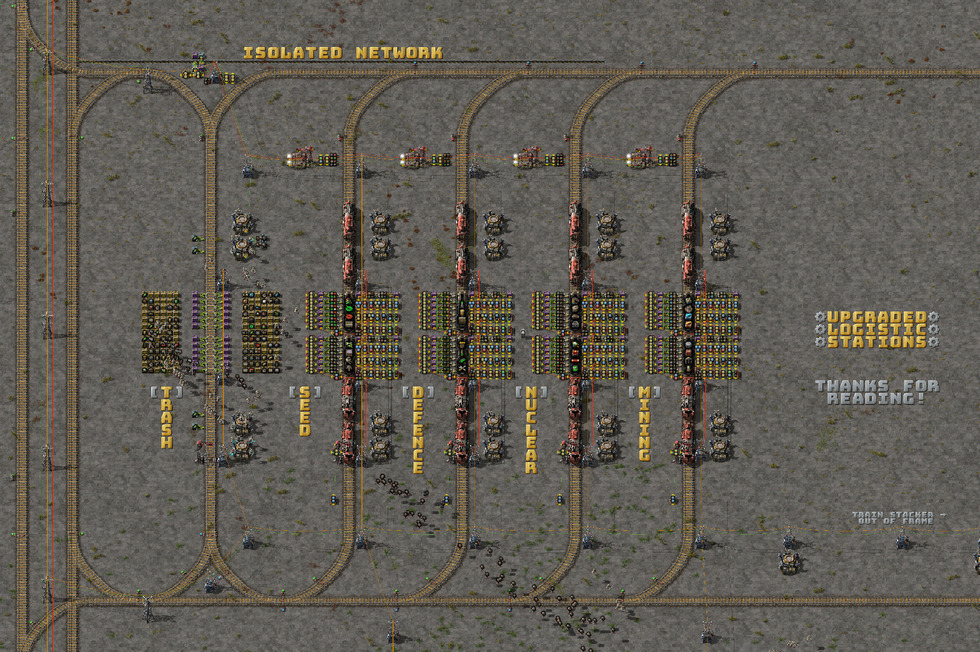
Included in the blueprint book below.
Blueprint book!
I’d love to hear your feedback, corrections, contributions, and fixes!
Email me at mason.larobina@gmail.com or raise an issue on the GitHub repo.
For updates, star the repo or follow:
https://github.com/mason-larobina/factorio/commits/master.atom